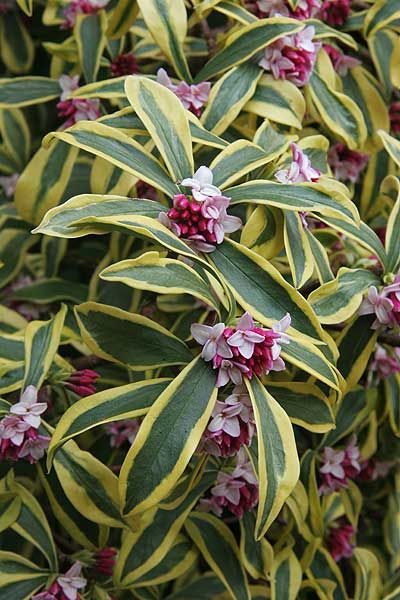
I first encountered Daphne odora at The Garden House in Devon 14 years ago, when a wonderful fragrance wafted across the garden. I traced it to this compact gloriously flowering shrub that I HAD to have. I bought a plant on the spot from the garden's small shop and carried it through Devon and back to Cambridgeshire where I kept it in a pot and then gave it to my mother-in-law when we moved to America.
It was one of the first shrubs I bought when we moved to Pennsylvania. I have it in the shrub border by the kitchen window where I can breathe it's fragrance deeply when I venture out the mudroom door and can open the kitchen window and fill the room with scent.
I was back at the Garden house this March and saw no trace of the original shrub I fell in love with but in their garden shop they had a fantastic new cultivar, Daphne odora Rebeca which is an improvement on the most popular variegated daphne 'Aureomarginata'. Plain daphnes with their celestial scent and colourful flower clusters in March/April are an invaluable plant. Those with variegated foliage I think are one of the finest of all garden shrubs and Rebecca takes it to another level with the flow colour, fragrance and a much broader yellow edge to the leaf so that the foliage colour really makes an impact and should bring colour to the garden until the end of fall. Discovered in Devon in 1989 by nurseryman Steven Watson it became available commercially in the UK a few years ago but I cannot find it for sale here as yet.
The Facts
Family: Thymelaeaceae
Genus: Daphne Species: odora Common Name: Winter or Fragrant Daphne
Area of Origin: China
Characteristics: A densely branched, mounded evergreen shrub that reaches 4' (6') in height and width. Alternate, simple, evergreen, leathery, elliptic-oblong leaves. The fragrant, rosy pale pink/white flowers are borne in 1" diameter, terminal heads with up to 10 florets during February - March. They last a long time and the fragrance is wonderful. Fruits are supposedly red but I've never seen one. It performs well in shade and is not meant to be as finicky about soil as other Daphne species. Dirr says "What a wonderful plant! Temperamental, trying, but worth all the attention."
Hardiness: USDA Zones 7 to 9 (though we're 6, hence the very sheltered position).
Cultivation needs: Temperamental, reportedly short lived, prefers part shade. They dislike disturbance and once planted should be left there. Sometimes they die for no apparent reason, very fastidious about culture, overly wet soil appears to doom them. Still a plant of the first order that is absolutely stunning in flower
Typical Pests, Diseases, associated problems: leaf spots, crown rot, twig blight, canker, viruses, aphids, mealybug and scale.
Propagation Method: Dirr used to think propogation was as "easy as cutting warm butter" but now claims to have varied success. Timing seems to be important when gathering cuttings, covered frame and shade cloth etc. To the nursery I go.
It was one of the first shrubs I bought when we moved to Pennsylvania. I have it in the shrub border by the kitchen window where I can breathe it's fragrance deeply when I venture out the mudroom door and can open the kitchen window and fill the room with scent.
I was back at the Garden house this March and saw no trace of the original shrub I fell in love with but in their garden shop they had a fantastic new cultivar, Daphne odora Rebeca which is an improvement on the most popular variegated daphne 'Aureomarginata'. Plain daphnes with their celestial scent and colourful flower clusters in March/April are an invaluable plant. Those with variegated foliage I think are one of the finest of all garden shrubs and Rebecca takes it to another level with the flow colour, fragrance and a much broader yellow edge to the leaf so that the foliage colour really makes an impact and should bring colour to the garden until the end of fall. Discovered in Devon in 1989 by nurseryman Steven Watson it became available commercially in the UK a few years ago but I cannot find it for sale here as yet.
The Facts
Family: Thymelaeaceae
Genus: Daphne Species: odora Common Name: Winter or Fragrant Daphne
Area of Origin: China
Characteristics: A densely branched, mounded evergreen shrub that reaches 4' (6') in height and width. Alternate, simple, evergreen, leathery, elliptic-oblong leaves. The fragrant, rosy pale pink/white flowers are borne in 1" diameter, terminal heads with up to 10 florets during February - March. They last a long time and the fragrance is wonderful. Fruits are supposedly red but I've never seen one. It performs well in shade and is not meant to be as finicky about soil as other Daphne species. Dirr says "What a wonderful plant! Temperamental, trying, but worth all the attention."
Hardiness: USDA Zones 7 to 9 (though we're 6, hence the very sheltered position).
Cultivation needs: Temperamental, reportedly short lived, prefers part shade. They dislike disturbance and once planted should be left there. Sometimes they die for no apparent reason, very fastidious about culture, overly wet soil appears to doom them. Still a plant of the first order that is absolutely stunning in flower
Typical Pests, Diseases, associated problems: leaf spots, crown rot, twig blight, canker, viruses, aphids, mealybug and scale.
Propagation Method: Dirr used to think propogation was as "easy as cutting warm butter" but now claims to have varied success. Timing seems to be important when gathering cuttings, covered frame and shade cloth etc. To the nursery I go.

 RSS Feed
RSS Feed
